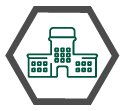
Steps in writing effective learning outcomes:
- Identify the intended audience.
Begin by determining who will be the target audience for your learning experience.
This could be a specific group of students in a specific course or workers in a specific
department.
- Define the purpose.
The learning experience's goal should be made very clear. What do you hope students
will be able to know and do once the learning process is over?
- Use action verbs.
Learning outcomes should describe observable behaviors or actions that the learners
will be able to perform after completing the learning experience. Use action verbs
to describe the behaviors, such as "analyze," "evaluate," "create," or "demonstrate."
- Be specific.
Learning outcomes should be specific and measurable. Use clear language to describe
exactly what learners will be able to do and how they will demonstrate their knowledge
or skills. Use the SMART format (specific, measurable, attainable, relevant, timely).
- Align with program objectives.
Ensure that the course learning outcomes align with the program objectives. This helps
ensure that the learning experience is focused and targeted towards achieving specific
program goals.
- Assess for mastery.
Ensure that the learning outcomes can be assessed for mastery. This means that you
need to be able to measure whether learners have actually achieved the intended learning
outcomes.
- Revise and refine.
Finally, review and revise the learning outcomes as needed. Seek feedback from learners,
subject matter experts, and colleagues to refine the learning outcomes to ensure that
they are clear, concise, and effective.
Overall, effective learning outcomes should be specific, measurable, and aligned with
the program objectives. By following these steps, you can write learning outcomes
that help learners achieve their goals and improve their knowledge and skills.
BONUS: Watch this informative video from ATU College of eTech's Professional Development
Video Series. The first video focuses on goals (outcomes) and assessment.

Steps in writing effective operational outcomes:
- Identify the area of focus.
Start by identifying the area of focus for your operational outcome. This could be
a specific department, process, or system within your organization.
- Define the purpose.
Clearly define the purpose of the operational outcome. What specific operational activities
do you want to measure and improve?
- Use action verbs.
Operational outcomes should describe observable behaviors or actions that the organization
or department will be able to perform after completing the operational activities.
Use action verbs to describe the behaviors, such as "improve," "reduce," "increase,"
or "streamline."
- Be specific.
Operational outcomes should be specific and measurable. Use clear language to describe
exactly what the organization or department will be able to do and how they will demonstrate
their success. Use the SMART format (specific, measurable, attainable, relevant, timely).
- Align with organizational goals.
Ensure that the operational outcomes align with the overall goals and objectives of
the organization, such as ATU Stragetic Plan Goals and ATU General Education Goals.
This helps ensure that the operational activities are focused and targeted towards
achieving specific university goals.
- Develop a measurement plan.
Develop a plan to measure the success of the operational outcome. This could include
developing specific metrics, establishing a baseline, and tracking progress over time.
- Revise and refine.
Finally, review and revise the operational outcomes as needed. Seek feedback from
stakeholders, subject matter experts, and colleagues to refine the operational outcomes
to ensure that they are clear, concise, and effective.
Overall, effective operational outcomes should be specific, measurable, and aligned
with university goals and objectives. By following these steps, you can write operational
outcomes that help the university improve its operational activities and achieve its
goals.



